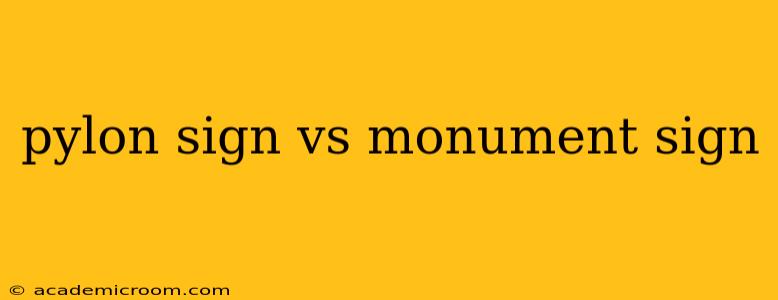Choosing between a pylon sign and a monument sign for your business can be a significant decision. Both are impactful, freestanding signs, but they cater to different needs and aesthetics. Understanding their key differences will help you select the perfect sign to enhance your brand visibility and attract customers. This guide will explore the nuances of each, highlighting their strengths and weaknesses to inform your choice.
What is a Pylon Sign?
A pylon sign is a tall, freestanding structure often featuring two or more faces, showcasing your business's name and logo prominently. They're commonly used for businesses with large parking lots, multiple entrances, or a need for high visibility from a distance. Think of the iconic signs seen along highways or at shopping malls—those are frequently pylon signs.
Advantages of Pylon Signs:
- High Visibility: Their height and multiple faces ensure maximum visibility from long distances, perfect for attracting drivers and passersby.
- Brand Recognition: The large format allows for impressive branding opportunities, showcasing your logo and messaging clearly.
- Illumination Options: Pylon signs can easily incorporate powerful lighting, maximizing visibility even at night.
- Multiple Signage: Ideal for businesses with multiple entrances or services, enabling clear directional guidance.
Disadvantages of Pylon Signs:
- Cost: Pylon signs are typically more expensive to manufacture and install than monument signs due to their size and complexity.
- Permitting: Obtaining permits for pylon signs can be more challenging due to their height and potential impact on the surrounding environment.
- Maintenance: Their size necessitates more frequent maintenance and potential repairs.
- Site Restrictions: Installation requires ample space and may be limited by zoning regulations or site constraints.
What is a Monument Sign?
A monument sign is a shorter, more grounded sign typically built with more substantial and durable materials. They often integrate seamlessly into the landscaping, providing a sophisticated and permanent presence. They're often preferred for businesses that want a more refined and integrated look.
Advantages of Monument Signs:
- Aesthetic Appeal: Monument signs offer a more sophisticated and elegant look, enhancing the overall curb appeal of your property.
- Durability: Constructed from high-quality materials like stone, brick, or concrete, they are built to last.
- Customizability: Monument signs offer extensive design flexibility, allowing for integration of various materials and finishes.
- Lower Cost (Generally): Compared to pylon signs, monument signs tend to be less expensive to produce and install.
Disadvantages of Monument Signs:
- Limited Visibility: Their shorter height results in less visibility from long distances compared to pylon signs.
- Less Illumination Potential: Incorporating lighting can be more challenging and may not be as impactful as with pylon signs.
- Smaller Signage Area: The reduced size limits the amount of information that can be displayed.
- Site Restrictions: Although generally less restrictive than pylon signs, site considerations and landscaping still play a role in their placement.
Pylon Sign vs. Monument Sign: Which One is Right for You?
The best choice depends entirely on your specific business needs and location. Consider these factors:
- Visibility Needs: Do you need high visibility from a long distance, or will a more subtle presence suffice?
- Budget: Pylon signs typically have higher upfront and maintenance costs.
- Aesthetics: Do you want a modern, eye-catching sign or a more refined, integrated look?
- Zoning Regulations: Check local regulations regarding sign height, size, and placement.
- Location and Surroundings: Consider the existing landscape and surrounding structures.
What are the different types of pylon signs?
Pylon signs come in various forms, including single-sided, double-sided, and multi-tenant configurations. The design and materials used can also vary greatly, impacting both the overall aesthetic and cost. Some are built with simple metal frameworks and illuminated lettering, while others incorporate more elaborate designs and materials. The choice depends on your specific needs and branding goals.
What materials are used for monument signs?
Monument signs utilize a range of materials, selected based on durability, aesthetics, and budget. Common materials include:
- Stone (Granite, Marble): Provides a classic, high-end look.
- Brick: Offers a traditional and durable option.
- Concrete: A cost-effective and versatile choice.
- Metal (Aluminum, Stainless Steel): Provides a modern and sleek appearance.
- Wood: Can create a rustic or natural aesthetic, though may require more maintenance.
How much does a pylon sign cost?
The cost of a pylon sign can vary significantly depending on size, design complexity, materials used, and location. Expect a substantial investment, potentially ranging from several thousand to tens of thousands of dollars.
How much does a monument sign cost?
Similar to pylon signs, monument sign costs are highly variable, influenced by factors like size, materials, design complexity, and installation. Generally, however, monument signs tend to be less expensive than pylon signs.
By carefully weighing these factors and considering your unique business requirements, you can choose the sign that best enhances your brand image and effectively attracts customers. Remember to consult with a professional sign company for expert advice and guidance throughout the process.
